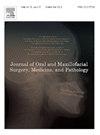A case of plasma cell leukemia with initial symptoms in the oral cavity
IF 0.4
Q4 DENTISTRY, ORAL SURGERY & MEDICINE
Journal of Oral and Maxillofacial Surgery Medicine and Pathology
Pub Date : 2024-09-24
DOI:10.1016/j.ajoms.2024.09.011
引用次数: 0
Abstract
Plasma cell leukemia (PCL) is a type of plasma cell neoplasm (PCN) and is very rare, accounting for 1–4 % of PCNs. PCL progresses rapidly and has a very poor prognosis. Extramedullary lesions in the oral cavity are extremely rare. We herein report a case in which a mass in the oral cavity was the initial symptom, with PCL subsequently identified. The patient was a 72-year-old woman. Mass formation was observed on the palatal side of upper left first molar, and the tooth was extracted at another hospital. The patient was referred to our department for a close examination and treatment because the mass had increased. At the time of the initial examination, a 20 × 15 mm, smooth, elastic, slightly hard mass was observed in the area corresponding to the extraction socket of the upper left first molar. A biopsy was performed under local anesthesia and an interim report suggested malignancy tumor. Blood tests were performed and the white blood cell count had increased to 45,800 /µL, and plasma cells accounted for 50.5 % of the total. The patient was referred to a hematologist and was diagnosis with PCL. The final diagnosis of the biopsy was invasion of PCL. After chemotherapy, the oral mass disappeared, but the patient died five months after the start of treatment. When a mass formation is observed in the oral cavity, it is necessary to examine the patient with hematological diseases in mind, and it is important to perform blood tests as appropriate.
求助全文
约1分钟内获得全文
求助全文
来源期刊

Journal of Oral and Maxillofacial Surgery Medicine and Pathology
DENTISTRY, ORAL SURGERY & MEDICINE-
CiteScore
0.80
自引率
0.00%
发文量
129
审稿时长
83 days
 求助内容:
求助内容: 应助结果提醒方式:
应助结果提醒方式:


